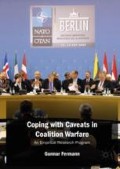Abstract
The reasoning of a conception of caveats that are both recognizable to military professionals and discrete and nuanced enough to be useful in empirical research, requires the reviewing of the post-Cold War experience with caveats and the mechanism of rules of engagement (RoE) in the regulation of the use of force. RoE is not a recipe for the use of force in combat, but guidelines as to when, where against whom, and how military force be used, and who has the authority to make such decisions. Situational judgment needs to be applied in the interpretation of RoE and relies on both local and prior knowledge to make optimal trade-offs between military and political concerns. RoEs vary regarding how specific, delegative, and robust formulated. The coalition RoE is a key yardstick against which national reservations on the use of force (caveats) be measured.
Access this chapter
Tax calculation will be finalised at checkout
Purchases are for personal use only
References
Auerswald, D. P., & Saideman, S. M. (2012). Coalitions at the Limits—NATO’s Restricted Effort in Afghanistan. In P. C. McMahon & J. W. Western (Eds.), The International Community and State-Building. Getting Its Act Together? Oxon: Routledge.
Auerswald, D. P., & Saideman, S. M. (2014). NATO in Afghanistan: Fighting Together, Fighting Alone. Princeton, NJ: Princeton University Press.
Bennett, D. A., & MacDonald, A. F. (1995). Coalition Rules of Engagement. Joint Force Quarterly, Summer(8), 124–125.
Berkowitz, B. D. (1994). Rules of Engagement for U.N. Peacekeeping Forces in Bosnia. Orbis, 38(4), 635–636.
Cimbala, S. J., & Forster, P. K. (2010). Multinational Military Intervention: NATO Policy and Burden-Sharing. Farnham: Ashgate.
De Cock, C. (2012). Operation Unified Protector: Targeting Densely Populated Areas in Libya. Military and Strategic Affairs, 4(2), 25–35.
De Mesquita, B. (2006). Principles of International Politics: People’s Powers, Preferences, and Perceptions. Washington: Congressional Quarterly.
de Nevers, R. (2007). NATO’s International Role in the Terrorist Era. International Security, 31(4), 34–66.
Fair, K. V. (1997). The Rules of Engagement in Somalia—A Judge Advocate’s Primer. Small Wars & Insurgencies, 8(1), 107–126.
Feaver, Peter D. (1992). Guarding the Guardians: Civilian Control of Nuclear Weapons in the United States. Ithaca: Cornell University Press.
Findlay, Trevor. (2002). The Use of Force in UN Peace Operations. Oxford: Oxford University Press.
Frost-Nielsen, P. M. (2018, forthcoming): Bringing Military Conduct Out of the Shadow of Law: Towards a Holistic Understanding of Rules of Engagement (ROE). Journal of Military Ethics, 17(1–2).
George, A. L. (1991). The Tension Between “Military Logic” and Requirements of Diplomacy in Crisis Management. In A. L. George (Ed.), Avoiding War—Problems of Crisis Management (pp. 124–143). Boulder, CO: Westview Press.
Humphries, J. G. (1992). Operations Las and the Rules of Engagement in Operations Desert Shield and Desert Storm. Airpower Journal, 11(3), 25–41.
Husby, G. (2015). Fra hull i luften, til hull i Gaddafis bunker. Bruk av politiske reservasjoner på norsk militærmakt i flernasjonale koalisjonsoperasjoner. En komparativ studie av F-16 bidragene i Kosovo, Afghanistan og Libya, belyst gjennom utenrikspolitisk analyse. Master Thesis in Political Science, Trondheim: Department of Sociology and Political Science, Norwegian University of Science and Technology (NTNU).
King, A. (2006). The Word of Command—Communication and Cohesion in the Military. Armed Forces and Society, 32(4), 493–512.
Klep, C., & Winslow, D. (1999). Learning the Lessons the Hard Way—Somalia and Srebrenica Compared. Small Wars & Insurgencies, 10(2), 93–137.
Kreps, S. (2008). When Does the Mission Determine the Coalition? The Logic of Multilateral Intervention and the Case of Afghanistan. Security Studies, 17(3), 531–567.
Levy, J. S. (2008). Case Studies: Types, Designs, and Logics of Inference. Conflict Management and Peace Science, 25(1), 1–18.
Lorenz, F. M. (1995). Forging Rules of Engagement: Lessons Learned in Operation United Shield. Military Review, 75(6), 17–25.
Marten, K. (2007). State-Building and Force: The Proper Role of Foreign Militaries. Journal of Intervention and Statebuilding, 1(2), 231–247.
Miller, E. S. (1995). Inter-operability of Rules of Engagement in Multinational Maritime Operations. Arlington, VA: Center for Naval Analysis.
Noetzel, T., & Schreer, B. (2009). Does a Multi-tier NATO Matter? The Atlantic Alliance and the Process of Strategic Change. International Affairs, 85(2), 211–226.
Osiel, M. J. (2002). Obeying Orders—Atrocity, Military Discipline and the Law of War. Piscataway, NJ: Transaction Publishers.
Palin, R. H. (1995). Multinational Military Forces: Problems and Prospects (Adelphi Papers No. 294). Oxford: Oxford University Press.
Parks, W. H. (1989). Righting the Rules of Engagement. U.S. Navy Institute Proceedings, 115(5), 83–93.
Phillips, G. R. (1993). Rules of Engagement: A Primer. The Army Lawyer, July(4), 4–27.
Reed, R. M. (2000). Chariots of Fire: Rules of Engagement in Operation Deliberate Force. Maxwell AFB, AL: Air University Press.
Ringsmose, J. (2010). NATO Burden-Sharing Redux: Continuity and Change After the Cold War. Contemporary Security Policy, 31(2), 319–338.
Roman, P. J. (1998). Ike’s Hair-Trigger: U.S. Nuclear Predelegation, 1953–60. Security Studies, 7(4), 121–164.
Rost, N., & Greig, M. G. (2011). Taking Matters Into Their Own Hands: An Analysis of the Determinants of State-Conducted Peacekeeping in Civil Wars. Journal of Peace Research, 48(2), 171–184.
Sagan, S. D. (1991). Rules of Engagement. In A. L. George (Ed.), Avoiding War—Problems of Crisis Management (pp. 443–470). Boulder, CO: Westview Press.
Saideman, S. M., & Auerswald, D. P. (2012). Comparing Caveats: Understanding the Sources of National Restrictions upon NATO’s Mission in Afghanistan. International Studies Quarterly, 56(1), 67–84.
von Clausewitz, C. (1976 [1832]). On War. Oxford: Oxford University Press.
Zinni, A. C., & Lorenz, F. M. (2000). Command, Control, and Rules of Engagement in United Nations Operations. In J. N. Moore & A. Morrison (Eds.), Strengthening the United Nations and Enhancing War Prevention (pp. 203–249). Durham, NC: Carolina Academic Press.
Author information
Authors and Affiliations
Corresponding author
Rights and permissions
Copyright information
© 2019 The Author(s)
About this chapter
Cite this chapter
Fermann, G. (2019). Regulation of the Use of Force in Military Organization and Coalition Forces. In: Coping with Caveats in Coalition Warfare. Palgrave Macmillan, Cham. https://doi.org/10.1007/978-3-319-92519-6_3
Download citation
DOI: https://doi.org/10.1007/978-3-319-92519-6_3
Published:
Publisher Name: Palgrave Macmillan, Cham
Print ISBN: 978-3-319-92518-9
Online ISBN: 978-3-319-92519-6
eBook Packages: Political Science and International StudiesPolitical Science and International Studies (R0)

